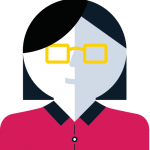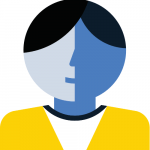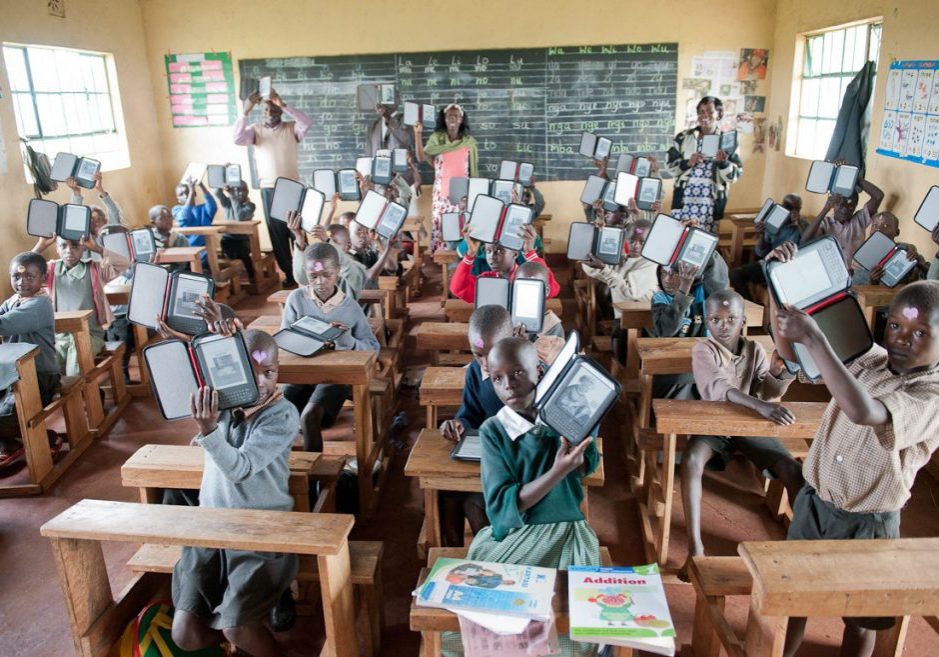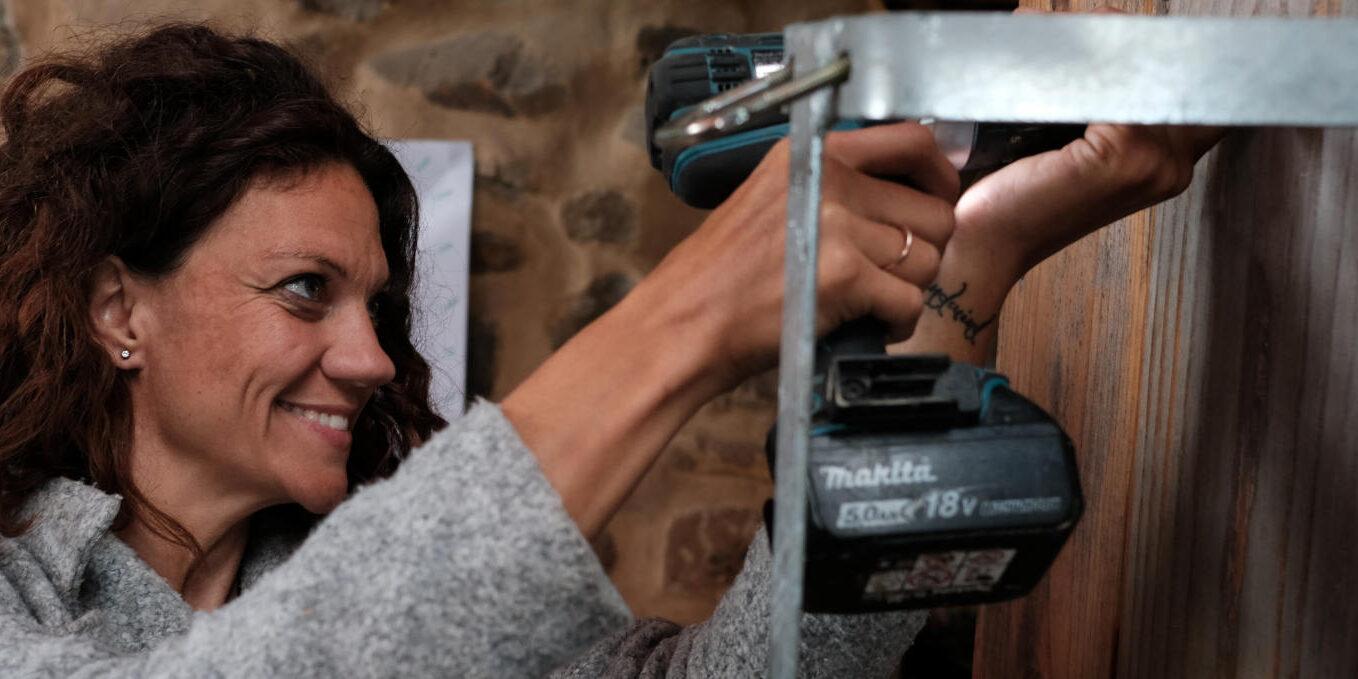What to expect
To provide real-life examples to the sometimes-abstract-sounding concepts in this training, there are two personas that will serve as guides. Adam is a Grant Applicant from Sri Lanka who is interested in applying for Foundation funding for a specific project. Mariam is a Monitoring, Evaluation, and Learning (MEL) Expert that represents the Foundation.
 Mariam: "This module walks you through the initial steps of building your grant application. Through following each of these steps, by the end of this section you will have a clearly defined Problem Statement that is informed by research and previous projects. This will lead you to a Project Goal, a Theory of Change (ToC), and Objectives, which will all make it easy to define your activities – the last step in this module.
Mariam: "This module walks you through the initial steps of building your grant application. Through following each of these steps, by the end of this section you will have a clearly defined Problem Statement that is informed by research and previous projects. This will lead you to a Project Goal, a Theory of Change (ToC), and Objectives, which will all make it easy to define your activities – the last step in this module.
You will also have the option to draft a logic model which can serve as a map to success for your project. There are templates for each of these elements in the Annex, all you need to do is do the thinking and fill them out."
Develop a problem statement
A problem statement is a description of the problem that the project is seeking to address. It should include detailed, on-the-ground information that describes the challenges that the target communities are facing, the structural obstacles and any other factors that are involved. You can utilize recent articles and research that describe the problem as a good place to start, but make sure that your statement provides your unique perspective and knowledge of the topic.
Consider organizing a reflection session with your team. Ask the question, why is this project necessary for the target community? Write it down and consider the elements that are needed to address this problem based on your organization’s expertise. You can utilize these meeting prompts to help guide the session.
Look back at research and previous projects
Working from the lens of the identified problem, look back into your internal organization files to find any available information on the problem and how it has been addressed in the past. Good places to look would be final reports from related projects, research and analysis (published or conducted internally). You should also speak to relevant team members and partners where necessary/appropriate in order to ensure you are getting a full picture of the results of past programming and research that already exists. Through this process you can identify what kinds of initiatives were successful in the past, and which ones were not. It will help you refine your problem analysis and perhaps point you towards the kind of work your organization is best placed to do, and the resources you may need to be successful. All of this should inform a baseline for where your organization will start from for this new grant application.
Guidance Modules
Women are not benefiting from opportunities in the emerging internet technology sector in Sri Lanka.
Example statement
Top tip
It is important that you focus on a problem that relates to the Foundation’s work. Pitch your problem at a level that is not too high (for example, “gender inequality and discrimination in the tech industry”), and instead break this problem down into its parts and causes and choose a factor you can genuinely influence with the resources you have available/are applying for (for example, lack of skills and confidence, lack of opportunities, etc).
 Mariam: "Has your organization done anything like this before, so you could learn from it?"
Mariam: "Has your organization done anything like this before, so you could learn from it?"
 Adam: "Well we haven’t directly, but one of our team members has run workshops like this at the school where she works. What should I ask her?"
Adam: "Well we haven’t directly, but one of our team members has run workshops like this at the school where she works. What should I ask her?"
 Mariam: "You could ask:
Mariam: "You could ask:
- What types of trainings work best for young girls of that age?
- What is the baseline knowledge on IoT topics that these girls will already have based on the school’s work?
- How would you describe your organization’s capacity to implement this project, do you have people with the required knowledge at hand and trainers experienced with this age group?
- How would you describe the capacity of the organizations you will partner with?
- What were the results last time you partnered with them?
These are just ideas though. Make sure you learn as much as possible about each of the answers she gives – just have an in-depth conversation!"
Top tip
Don’t ask “do you think that project was successful”, instead ask “did that project solve the problem it was designed to solve? Why (not)?” That way, you or people you interview don’t automatically justify previous work but look at it critically with the problem in mind.
Develop a project goal
A project goal is the overarching aim of the project. What do you want to achieve as a result of the project? The best goals use clear and concise language and encompass the expected results of the project as a larger impact within the community. The project goal is frequently not something that can be clearly proven through the data collected on the project, so you won’t plan on measuring this specifically. Think of your goal as your vision for the project.
To get started, review the Foundation’s priorities and look for overlaps with your problem statement.
Women in Sri Lanka can have successful careers in the emerging Internet technology sector.
Project goal (impact)

Top tip
Brainstorm this with your team, and ideally with some of your beneficiaries. First write down all of the ideas for goals that are important to people in the room, then order them on a spectrum between the goals that are “more achievable” and “further in the future”.
 Adam: "I think our goal should be girls applying to early-career opportunities in the tech sector in Sri Lanka."
Adam: "I think our goal should be girls applying to early-career opportunities in the tech sector in Sri Lanka."
 Mariam: "That sounds like a good way to frame the goal, but I would recommend you host a reflection session with relevant team members to discuss the potential solutions you could provide for this problem statement, and what the result would look like. You can conduct this reflection session guided with these prompts. At this level, your goal should be more about structural change than an individual, how about “Women have successful careers in the emerging internet technology sector”?"
Mariam: "That sounds like a good way to frame the goal, but I would recommend you host a reflection session with relevant team members to discuss the potential solutions you could provide for this problem statement, and what the result would look like. You can conduct this reflection session guided with these prompts. At this level, your goal should be more about structural change than an individual, how about “Women have successful careers in the emerging internet technology sector”?"
Develop a Theory of Change (ToC)
A theory of change describes the logic that serves as the basis of your project. It is often an IF, THEN statement with language that generally encompasses the activities and subsequent changes that will occur as a result of successfully implementing a project. To develop your project theory of change, consider the following questions:
- What is the overall goal of the project?
- What needs to change in order to achieve that? (Think about individuals, organizations, relationships, opportunities, perhaps legal and social norms)
- What activities are necessary to achieving the objectives?
- Who are the main actors involved? What type of support do they need?
This exercise – like all MEL practices – is not stagnant and requires iteration, collaboration and engagement from team members in order to be useful and successful. When you first do this as part of your proposal development, you will likely not have all the relevant information, you will learn new aspects of this theory of change during implementation. When you look at your monitoring data and evaluate it, look back at this theory of change and discuss which parts may need adjusting. If you and your team agree that substantial changes (for example, dropping an objective that has become unattainable) will be needed during the implementation phase of the project, please get in touch with your point of contact at the Foundation.
 Adam: "Applying that to our project in Sri Lanka: IF we organize workshops for schoolgirls to develop their skills and form important connections, THEN... then what?"
Adam: "Applying that to our project in Sri Lanka: IF we organize workshops for schoolgirls to develop their skills and form important connections, THEN... then what?"
 Mariam: "...THEN they will have more skills and opportunities to start a career in the tech sector. That is what you want to achieve, the part of the problem you can address, right?"
Mariam: "...THEN they will have more skills and opportunities to start a career in the tech sector. That is what you want to achieve, the part of the problem you can address, right?"
 Adam: "Well that is only half the project. We also need to make sure the schools, employers, and other related stakeholders are working together to enable careers for the girls we train, otherwise they will still have that problem even though they have stronger skills. So, IF we bring potential employers, educational institutions and other relevant stakeholders together to discuss how they would all benefit from better opportunities for young women in tech, THEN they will collaboratively establish ways to facilitate these career paths."
Adam: "Well that is only half the project. We also need to make sure the schools, employers, and other related stakeholders are working together to enable careers for the girls we train, otherwise they will still have that problem even though they have stronger skills. So, IF we bring potential employers, educational institutions and other relevant stakeholders together to discuss how they would all benefit from better opportunities for young women in tech, THEN they will collaboratively establish ways to facilitate these career paths."
Top tips
Try using active statements for the elements of your theory of change. For example, don’t name the goal “Less discrimination in the workplace”, instead name it “employers actively combat and mitigate for discrimination in the workplace”. That will make it easier for you and your partners to design activities and measure success later.
As you develop your theory of change, you will notice that some of the goals your project would like to achieve are harder to achieve or further along a line of events than others. The long-term goal you developed in the section ‘Develop a Project Goal’ will not be achieved overnight, or possibly not even within the timeframe of your project – this is called the “impact goal”.
Example Theory of Change
IF we organize workshops for schoolgirls to develop their skills and form important connections, THEN they will have more skills and opportunities to start a career in the tech sector.
IF we bring potential employers, educational institutions and other relevant stakeholders together to discuss how they would all benefit from better opportunities for young women in tech, THEN they will collaboratively establish ways to facilitate these career paths.
Develop objective/s
Objectives are the expected results of the activities - that can be directly measured. Objectives are the step below the project goal. While it is difficult to measure achievement of the overall impact goal as outlined in the previous “goal” section, it is important to measure whether you are on the right track. Therefore, your proposal should include more short-term goals indicating success: objectives.
You can think of the objectives as the link between the various activities and the project goal. For most projects, don’t expect to have more than two objectives contributing to the overall goal – often just one is best. The number of objectives can often be tied to the size of your project/the amount of funding you are requesting. More activities frequently lead to bigger projects that require more funding, which increases the likelihood that you will have more than one objective. If you do have multiple objectives, it’s important to ensure that they all contribute to the overall project goal.
It is also crucial that your objectives are SMART (specific, measurable, achievable, relevant, time-bound).
To increase Sri Lankan female university students and schoolgirls participation in emerging Internet technology careers through a multi-stakeholder platform.
Example objective
Top tips
For each objective you discuss, ask “how would we know when we have achieved this?” to make sure it is concrete enough.
 Adam: "Hang on, this is starting to get a bit confusing. So, we have a project goal, and now we are supposed to develop objectives? Aren’t these very similar things?"
Adam: "Hang on, this is starting to get a bit confusing. So, we have a project goal, and now we are supposed to develop objectives? Aren’t these very similar things?"
 Mariam: "They may sound similar, but they are not the same. The project goal that you already have, “Women in Sri Lanka have successful careers in the emerging internet technology sector”, is obviously very high level – you cannot achieve it through this project alone, and certainly not in the short timeframe you have. Therefore, we will develop objectives as the kinds of changes that need to happen in order to achieve the overall project goal. So, what do you think would have to change about how young Sri Lankan women approach their careers, so that one day they would have successful careers in the emerging tech sector?"
Mariam: "They may sound similar, but they are not the same. The project goal that you already have, “Women in Sri Lanka have successful careers in the emerging internet technology sector”, is obviously very high level – you cannot achieve it through this project alone, and certainly not in the short timeframe you have. Therefore, we will develop objectives as the kinds of changes that need to happen in order to achieve the overall project goal. So, what do you think would have to change about how young Sri Lankan women approach their careers, so that one day they would have successful careers in the emerging tech sector?"
 Adam: "I think we would both need more girls and young women with the right skills and motivation, and we would need a support network for them. When we did our problem statement, we spoke about the many factors that make it hard for girls to start careers in that sector – we need parents, teachers, universities and employers to work together to break down these barriers. I would say our objective is to increase Sri Lankan female University students and schoolgirls participation in emerging Internet technology careers through a multi-stakeholder platform."
Adam: "I think we would both need more girls and young women with the right skills and motivation, and we would need a support network for them. When we did our problem statement, we spoke about the many factors that make it hard for girls to start careers in that sector – we need parents, teachers, universities and employers to work together to break down these barriers. I would say our objective is to increase Sri Lankan female University students and schoolgirls participation in emerging Internet technology careers through a multi-stakeholder platform."

Develop responsive activities
Discuss and define which activities are best suited to lead to your defined goals and objectives. As you describe your activities in the grant application, be very clear on the purpose of each of the activities, how they will help achieve your objectives, and give details on what they will look like. Working backwards from the theory of change and objectives ensures your activities are all aligned and have a maximum chance of adding up to the greatest possible impact. It also makes it easier to report on and communicate your impact.
Make sure to consider
- What is feasible – time, geography, budget. How much time will your activities take and how much will they cost? How can you scale them? What will be the costs for team members to manage them and to support partners in their work?
- The inputs – What types of resources do you have? Training materials? Expertise? How can you use them to address the needs of your community?
- Your partners and their experience carrying out activities. Have you worked with them before? What experience do they have and how do they work?
Top tip
Think about all the potential ways that you could achieve a certain objective, and then choose the most appropriate type of activity. For example, to gain knowledge and skills, is the most effective way to sit in a classroom and be taught, or could you organize a hands-on experience for your participants?
 Adam: "Oh, but I already had ideas about the activities we would run under this project before we started the process of defining problem, goals and theory of change. Is that bad?"
Adam: "Oh, but I already had ideas about the activities we would run under this project before we started the process of defining problem, goals and theory of change. Is that bad?"
 Mariam: "No, however, it is important to (re-)define them based on the goals and objectives you have set in the previous step. For example, we said the objective was to establish a multi-stakeholder platform for stakeholders to support young women into the tech sector. Do the activities you had in mind achieve that?"
Mariam: "No, however, it is important to (re-)define them based on the goals and objectives you have set in the previous step. For example, we said the objective was to establish a multi-stakeholder platform for stakeholders to support young women into the tech sector. Do the activities you had in mind achieve that?"
 Adam: "Not really. I thought we were going to run two workshops for University students to increase understanding and application of the Internet of Things (IoT), and then two boot camps for schoolgirls that provide an introduction to coding and application of the IoT. But I see we also need some sort of conference or networking meeting for the students to meet potential employers and other stakeholders, so they can all hear from each other and establish that platform."
Adam: "Not really. I thought we were going to run two workshops for University students to increase understanding and application of the Internet of Things (IoT), and then two boot camps for schoolgirls that provide an introduction to coding and application of the IoT. But I see we also need some sort of conference or networking meeting for the students to meet potential employers and other stakeholders, so they can all hear from each other and establish that platform."
Example (Activities)
- Develop a multi-stakeholder platform
- Host two workshops for University students to increase understanding and application of the Internet of Things (IoT).
- Host two boot camps that provide an introduction to coding and application of the IoT for schoolgirls.
Encouraged action:
Clarify your path to success
In order to clearly outline how your project intends to produce particular results, a good tool to use is called a logic model. It can be used to map out how the project will make or contribute to the changes outlined in your theory of change. When filling in the below diagram, ask yourself and your partners to critically reflect about each step:
- Which parts of this can we influence? What are the actions that we need to see from partners, participants, target community?
- How sure are we that what happens in (this box above) will lead to (this box below)? What does that depend on?
If you want to go through the exercise yourself (which is recommended, but not required by the Foundation), you can use this template.
Project activities
- Trainings, networking opportunities,...
- Infrastructure provision, tools,...
What the project will deliver
- Improved skills, knowledge, connections,...
- Access to relevant tools for more people,...
What participants will do as a result
- Use new skills to do X, apply and gain new (job) opportunities,...
- Use new tools and infrastructure to do Y, start new initiatives,...
 Adam: “For my project in Sri Lanka, I think the problem we are focusing on is gender inequality in the tech sector in Sri Lanka. Women are really disadvantaged in this sector, and you could say generally in society, so we want to help more women to start careers working with emerging internet technologies, where they can shape new solutions and have lucrative employment."
Adam: “For my project in Sri Lanka, I think the problem we are focusing on is gender inequality in the tech sector in Sri Lanka. Women are really disadvantaged in this sector, and you could say generally in society, so we want to help more women to start careers working with emerging internet technologies, where they can shape new solutions and have lucrative employment."
 Mariam: "That sounds good, but I think you may want to break that down a little more. I know most problems you might be interested in solving are complex, so they interlink with other problems, but you need to be careful to pick a problem that you understand well, and that is manageable enough to tackle through your project. You can use a “problem tree” tool to explore a problem, where you map the consequences of this initial problem as the leaves and branches (for example, fewer high-value job opportunities for women, tech tools designed without recognition of their impact on women, etc), and the causes of your problem are the roots (for example, social norms and biases, lack of skills and opportunities).
Mariam: "That sounds good, but I think you may want to break that down a little more. I know most problems you might be interested in solving are complex, so they interlink with other problems, but you need to be careful to pick a problem that you understand well, and that is manageable enough to tackle through your project. You can use a “problem tree” tool to explore a problem, where you map the consequences of this initial problem as the leaves and branches (for example, fewer high-value job opportunities for women, tech tools designed without recognition of their impact on women, etc), and the causes of your problem are the roots (for example, social norms and biases, lack of skills and opportunities).
Problems that are concrete enough to serve as the basis of your grant application are for example: the lack of internet infrastructure, lack of understanding of a certain topic (or series of topics), lack of collaboration between different stakeholders, lack of policy/laws in a country, region, or local community related to use of the internet, lack of connectivity among certain communities, and lack of representation within a community."
Ideal state
- Women have the same chances to succeed in tech as men,...
- Communities use the internet to enhance cultural and economic opportunities,...

